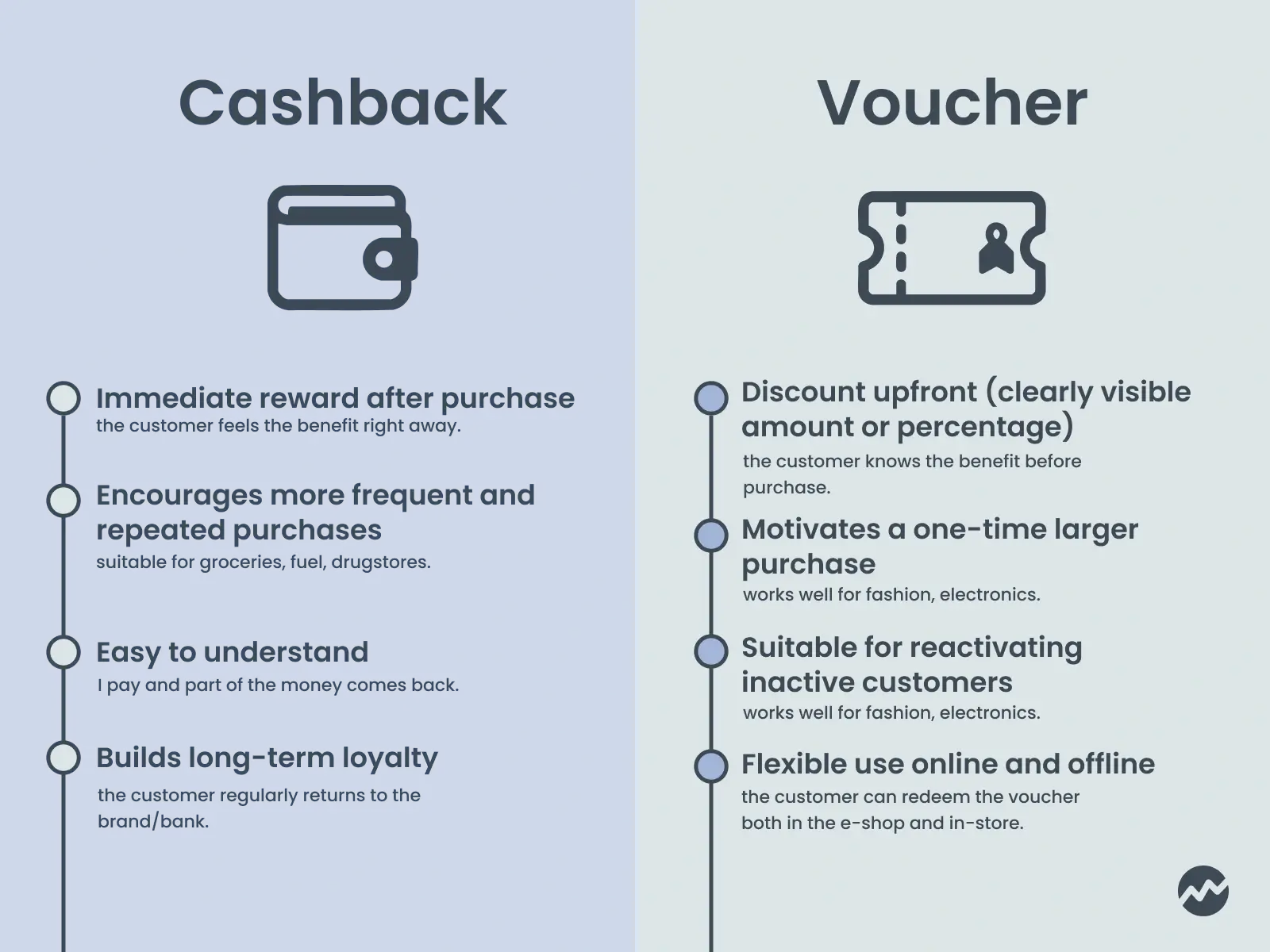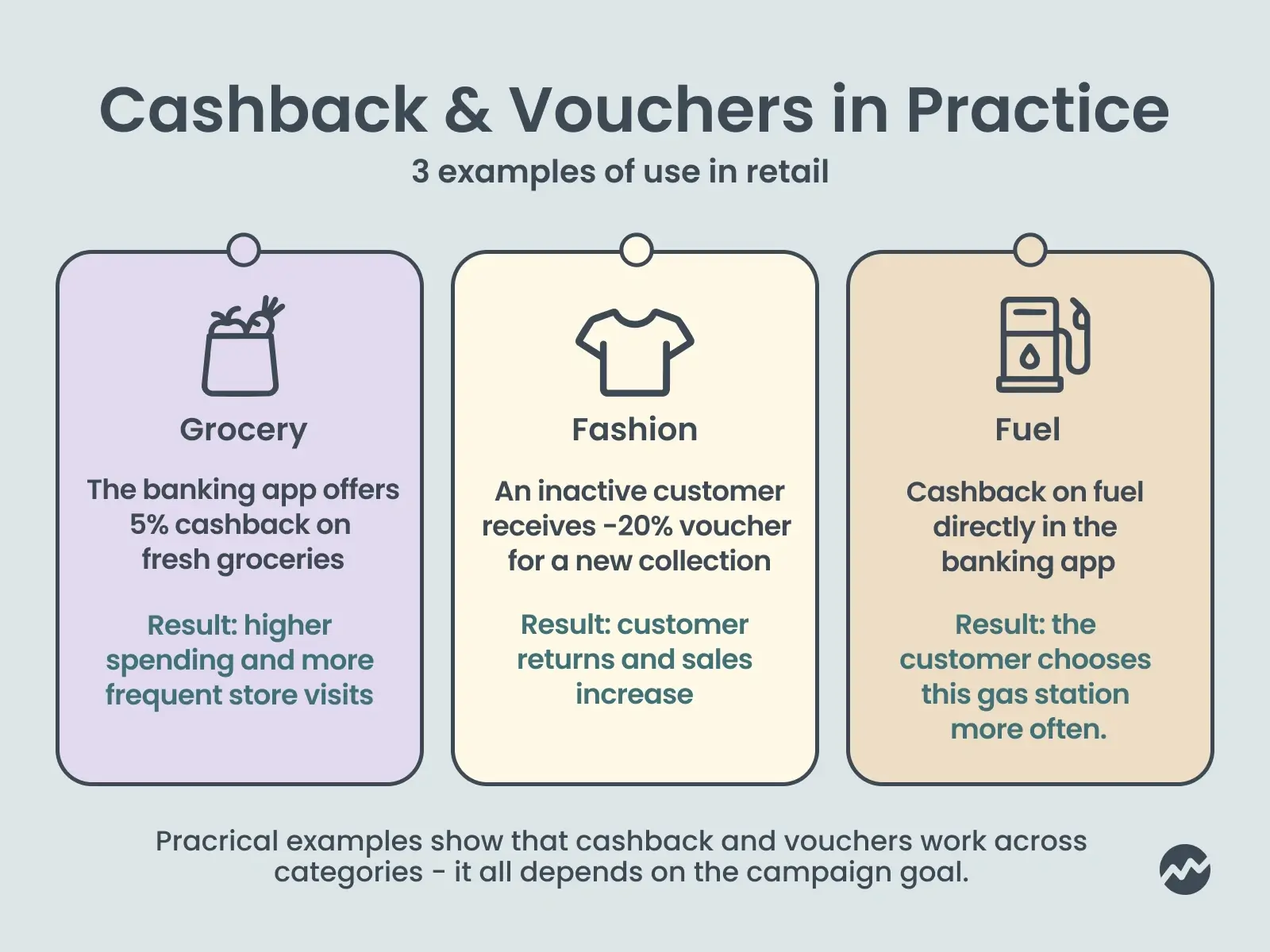Loyalty programs have come a long way. Do you still remember the paper cards where you collected stamps for each purchase? Or the mass coupons in newspapers that anyone could use? These tools had one thing in common - they were broad and impersonal.
But times have changed. Today’s customers don’t just want “something for something.” They expect brands to understand them, communicate in a personal way, and offer benefits that match their lifestyle.
And this is where data-driven marketing comes into play. Thanks to data, loyalty programs are evolving from simple reward systems into sophisticated tools that build long-term relationships between customer and brand. Personalised cashback and vouchers in banking apps play a key role here.

How data is changing loyalty programs
The era of one-size-fits-all loyalty is over. Data has transformed how brands understand, target, and reward their customers - moving loyalty programs from generic incentives to finely tuned systems that adapt to real behaviour. Instead of broad audience groups and static rewards, modern programs use transaction data, location insights, and behavioural triggers to deliver precisely what each customer values most.
From mass discounts to hyper-personalisation
One customer gets a fashion voucher, another receives cashback on fresh groceries. Relevance is the key: every in-app offer fits specific shopping habit. Purchase history, category preferences, and even timing patterns guide this personalisation. The result is a loyalty experience that feels curated, driving stronger engagement and higher redemption rates.
Real-time triggers
With access to anonymised, real-time data, brands can activate rewards exactly when they matter most. A push notification about a coffee discount can appear when a user walks near their favourite café. Someone who recently bought running shoes could be offered a cashback reward for sportswear or a fitness app subscription.
Cashback and vouchers as equal forms of rewards
Cashback and vouchers are two sides of the same loyalty coin, each with a distinct psychological effect. Cashback is effortless - the user pays by card, and a portion of the spend is automatically credited back. It reinforces a sense of reward without requiring any extra step. Vouchers, on the other hand, offer tangible upfront value - a visible discount percentage or fixed sum that can be redeemed online or in-store.
Omnichannel connection
Whether a customer shops online or visits a physical store, their rewards and offers remain synced and visible in one central hub - the banking app. This eliminates the friction of managing multiple loyalty cards, emails, or promo codes.

Benefits for companies
Card-linked offers and data-driven loyalty programs don’t just improve customer experience- they deliver measurable, sustained business impact. By integrating cashback and vouchers directly into the banking environment, companies can engage customers where they already manage their finances, creating a natural link between spending and rewards. The benefits are obvious:
Higher customer engagement: Unlike traditional loyalty channels that depend on external apps or physical cards, CLOs place offers directly in front of customers within their everyday banking app. This native placement drives exceptional visibility and interaction rates. Activation and redemption require no friction: the user sees an offer, activates it, pays with their card, and automatically receives the benefit. For merchants, this translates into real engagement with redemption rates that can outperform email or social campaigns several times over.
Revenue growth: Cashback rewards encourage ongoing engagement - customers return to earn small, recurring benefits, which builds habit and loyalty over time. Vouchers, on the other hand, trigger immediate action and typically drive higher-value baskets. Together, they form a dual strategy: cashback sustains frequency, vouchers accelerate volume. Retailers using both often see consistent revenue growth during and even after campaigns, as customers internalise the reward loop and continue shopping out of preference, not just promotion.
Behaviour prediction: By analysing past spending behaviour, merchants can determine which type of reward will have the greatest impact on each user. A customer who shops regularly may respond best to small, recurring cashback incentives, while a lapsed customer might be more likely to return for a limited-time voucher.
Measurability & ROI: Every CLO campaign is measurable from start to finish. Retailers can track who viewed and activated an offer, who completed a purchase, and how much additional revenue was generated as a result. Because all data comes from verified transactions, results are accurate and transparent.
Practical tips: Connecting offers with loyalty
- Relevance first
For both cashback and vouchers, less is more. Offer fewer campaigns, but with higher relevance. - Choose the right type of reward
Cashback works well when the goal is to support repeated, regular purchases. Vouchers are better to trigger one-off higher-value purchases or re-engage a lapsed customer. - Segmentation and prediction
Data analysis helps decide whom to provide the offer to, which locations to focus on, or what level of benefit to set, whether cashback or voucher. - Test and optimise
Run A/B tests to see whether cashback or a voucher works better in a given category, and optimise campaigns accordingly. - Connect bank and retailer
The real value for customers lies in seeing offers directly in their banking app: a trusted environment they use daily.
Real-life examples
Whether it’s grocery chains, fashion brands, or fuel networks, the mechanism is the same: real transaction data drives precise targeting, and measurable outcomes follow. Here’s how different sectors use CLOs to turn everyday purchases into loyalty moments.
Grocery Retail – Cashback
A banking app offers customers 10% cashback on fresh groceries. The result? Higher spending in this category and more frequent store visits. Over the campaign period, data shows not only an increase in average basket size but also a higher visit frequency, as shoppers integrate the offer into their routine spending.
Fashion – Voucher
A long-inactive customer receives a 20% voucher for the new collection. The offer reminds them of the brand and motivates them to return. This reactivation strategy works: the campaign not only brings lapsed users back but also exposes them to new products, often resulting in additional full-price purchases beyond the voucher redemption.
Fuel & Convenience – Cashback
When refueling, the customer receives cashback on fuel. This increases the likelihood they’ll choose this station again in the future. Over time, the network sees an increase in repeat visits and fuel volume per transaction, along with measurable share growth in key regions.

Conclusion
Data-driven marketing is transforming loyalty programs from simple reward tools into complex ecosystems of benefits. Cashback and vouchers are two core pillars from which partners choose according to their goals and strategy.
It makes sense. Customers no longer want generic coupons. They want relevant rewards, whether it’s money back or a discount voucher. And if it’s always available in their banking app, the chances of them coming back again and again increase significantly.
Curious how cashback or vouchers in banking apps can work for your business? Get in touch – we’ll be happy to show you how personalized rewards work in practice.
FAQs
Data-driven marketing is a strategy where marketing decisions are based on systematic analysis of transaction data and customer behaviour. It transforms loyalty by moving from mass coupons to hyper-personalised cashback and vouchers delivered via banking apps, ensuring rewards are relevant to the customer's actual shopping habits.
Data-driven marketing shifts loyalty from mass coupons to hyper-relevant rewards. Banks now use real-time data to deliver incentives that precisely match the customer’s actual shopping habits, significantly boosting engagement.
Cashback is used to encourage repeated, constant purchases due to its effortless nature. Vouchers are better for triggering immediate action or accelerating the volume of a single purchase.
The banking app is a trusted, high-visibility channel that customers use daily. This native placement drives exceptional engagement and activation rates because it eliminates the need for separate loyalty cards, linking spending and rewards naturally.
Data analysis allows merchants to predict the most effective incentive. A regular shopper will respond best to recurring cashback to sustain frequency. Conversely, lapsed customers often require a higher-value, limited-time voucher to motivate a return purchase.
Marketing professional with B2B, fintech, e-commerce, and retail experience. She connects banks and retailers through data-driven personalization and commerce media, turning complex topics into engaging stories.


